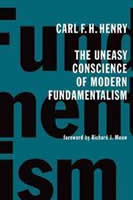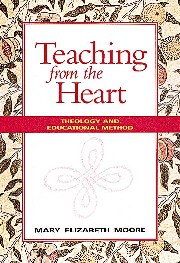
The Uneasy Conscience of Modern Fundamentalism. By Carl F. H. Henry. Originally published 1947; reprinted, Grand Rapids, MI: Eerdmans, 2003. 89 pages. Paperback, $12.00.
Carl F. H. Henry is back from the dead. And no, I’m not a fundamentalist so I don’t mean that literally, but I do suggest that Henry’s desire for fundamentalism in this book still finds resonance with today’s evangelical community. Although this book was written in the late 40’s, it seems to eerily touch on issues still pervasive within the evangelical movement 62 years after its original publication. Carl Henry’s The Uneasy Conscience of Modern Fundamentalism is a short but poignant read into what it really means to be an authentic evangelical. Moreover, this book is essentially a critique of fundamentalism and its inability to equip socially conscious evangelicals. It is a call for evangelicals to actively participate in the world through sound Christian engagement.
The year was 1947 and a young theologian still reeking of a freshly printed doctoral degree, authored a sharp and inspirational message that would usher in a new era of evangelicalism. From that point on, Henry is deemed as the preeminent scholar and founding father of modern evangelicalism. Henry would go on to help establish several institutions at the forefront of evangelicalism. Within a year, Henry, along with Harold Ockenga, Harold Lindsell and Edward John Carnell established Fuller Theological Seminary in California. In 1956, at the bequest of prominent evangelist Billy Graham, Henry started publication of a magazine with an intentional evangelical outlook called Christianity Today. He also played a founding role in the establishment of the National Association of Evangelicals. He authored several books such as, Christian Personal Ethics, Revelation and the Bible, Evangelicals at the Brink of Crisis, Faith at the Frontiers, Evangelicals in Search of Identity, The Christian Mindset in a Secular Society, Christian Countermoves in a Decadent Culture, Twilight of a Great Civilization, and Evangelical Affirmations. In 1987, Henry published his magnum opus titled God, Revelation and Authority. Indeed, Carl Henry led a distinguished career before dying in 2003.
If theological texts were evaluated by the number of pages instead of the content, then this book would be example par excellence of the phrase “size doesn’t matter.” In 89 pages, Henry lays the groundwork for a progressive form of fundamentalist theology. At the same time, Henry calls for a radical reformation of the current fundamentalist movement to accommodate changes in social and cultural realities. He writes during a time when the landscape of Christianity was dominated by a tumultuous turf-war between the secularizing pressures of liberalism and the religious fervor of fundamentalism. As a self-professing member of the fundamentalist movement, Henry starts by voicing an opinion of clear objection towards the fact that fundamentalism avoided meeting the concerns of society. He states,”Those who read with competence will know that the ‘uneasy conscience’ of which I write is not one troubled about the great Biblical verities; but rather one distressed by the frequent failure to apply them effectively to crucial problems confronting the modern mind” (xviii). This problem of ineptly applying biblical ethics is addressed powerfully at the outset of his book. In his introduction he states, “If the Bible-believing Christian is on the wrong side of social problems such as war, race, class, labor, liquor, imperialism, etc., it is time to get over the fence to the right side. The church needs a progressive Fundamentalism with a social message” (xx). Henry said little to clarify which side of war, race and class constitutes the “right” side. And what about fence sitting? Henry doesn’t seem to address the often cautious moderate-middle position of refusing to take obvious sides when it comes to volatile issues of war, race, class, etc.
Henry’s jaundiced disposition seemed obligatory when fundamentalist Christianity could not answer society’s cry for help. He further illustrates this point when speaking to a crowd of a hundred evangelical pastors and asks, “How many of you, during the past six months, have preached a sermon devoted in large part to a condemnation of such social evils as aggressive welfare, racial hatred and intolerance, the liquor traffic, exploitation of labor of management, or the like – a sermon containing not merely an incidental or illustrative reference, but directed mainly against such evils and proposing the framework in which you think solution is possible?” The saddened lack of response that followed, argues Henry, points to “a predominant trait, in most Fundamentalist preaching: this reluctance to come to grips with social evils” (4). The emphasis of fundamentalism was on individual sin over social evil. Fundamentalism would not answer the call for justice in society; instead the call would be answered by liberalism.
But lying with liberalism seemed like adultery to Henry. He was completely enamored by a supernaturalist worldview that emphasized biblical inerrancy and the redemptive work of Christ. This position was incompatible with mainstream liberalism. It forced individuals that wanted to keep an evangelical theology and fight for social reform to choose one over the other. In most cases, people would choose the former. Henry states, “The evangelicals were being locked up to the uncomfortable alterative of an attack on contemporary social reformers, seeking solution to admitted ills, or of going along with those whose ideology they did not endorse” (23). At this point, the task became clear for Henry. In the following chapters, Henry sought to reconcile a fundamentalist theology with the gospel message of social reform, from which it was divorced.
Being careful as to not repudiate fundamentalism proper, Henry made strides towards reforming fundamentalism from within. Henry was also careful to stay clear of a secular anti-supernaturalist orientation that could not hold a redemptive theology as a centrist position. Instead, Henry attempts to navigate the narrow middle-way by first appealing to Christianity’s historical precedent for social reform. In the chapter called, “The Most Embarrassing Evangelical Divorce,” Henry argued that for the first time, fundamentalism split Christianity from its social bonds. Henry boasts that historically Christianity has led the way in social movements. “Manifesting its true genius, Christianity furnished an idealistic atmosphere of judgment upon its environment in any age, and precipitated most of the successive reform movements within previous cultures” (28). Henry admired both the Old and New Testaments as revelatory to God’s redemptive work in the world. Following the tenants of biblical heroes like Moses, John, Paul and especially Jesus Christ, Henry continued to meld an evangelical theology and social outreach from a strong biblical perspective. He adds, “This does not mean that early Christianity charted the course for social reform; rather, it furnished the basic principles and the moral dynamic for such reform, and concentrated on regeneration as the guarantee of bettered conditions” (37). If conserving the main tenants of fundamentalism became a priority and recovering its historical legacy of social reform a necessity, then for Henry, the natural conclusion led to a rejection of non-evangelical theology as “inability to right the world order.”
In chapter 4 called, “The Apprehension Over Kingdom Preaching,” Henry takes a stance against dispensationalist thought and states, “it appears more in accord with the Biblical philosophy of history to think of the church age in terms of divine continuity rather than of parenthesis, in terms of the amazing unity of redemptive plan rather than in terms of an amazing interlude” (47). Henry was also against a kingdom view that over emphasized the here and now, much to the tune of a liberal social gospel. Preaching the kingdom must include both eschatological orientations adequate to the task of embedding a social message within fundamentalist theology. Chapter 5 called, “The Fundamentalist Thief on the Cross” seems to be a place where Henry consolidated his fundamentalist theology. More precisely, Henry chose this section to survey the main tenants of fundamentalist beliefs in order to properly identify fundamentalist views. This chapter served as a clarifying section of mislabeling or misunderstanding fundamentalism as anything other than properly conserved evangelical theology. Henry vividly illustrated this point through a poignant example. The personification of fundamentalism hangs on the right side of Jesus on the cross, namely in the form of a thief that was convinced of Jesus’ redemptive work. It is on this side and on the crutch of a supernaturalist framework in recognition of Jesus’ redemptive activity, that an authentic solution for society’s dilemmas is found. This illustration, of course, contrasts the superficial solution offered by the doomed liberal thinker hanging to Jesus’ left. In chapter 6, “The Struggle for a New World Mind,” Henry suggests that in order for evangelicalism to flourish, it must engage the world on two fronts. The first challenge is to “develop a competent literature in every field of study, on every level from the grade school through the university, which adequately presents each subject with its implications from the Christian as well as non-Christian points of view” (69). The second challenge is to remain confident in the Christian worldview despite obvious “state” or political indoctrination. The following two chapters serve as a call to unite all Christians under the banner of social betterment. But Henry’s inclusiveness has conditions. In example, liberals are invited to the mission of Jesus’ redemptive activity for society only insofar as a redemptive reference is “a live option for the achievement of good ends” (81).
Carl Henry’s The Uneasy Conscience of Modern Fundamentalism is arguably one the most important books for Christianity in the twentieth century. This book shows a high level of relevancy to today’s evangelical movement. This clearly attests to its significance. Sadly, it’s also a testament to the magnificent failure of the evangelical movement to apply Henry’s advice. Whether it’s the lack of a social outreach in some evangelical churches, or the acquiescence of evangelical theology in churches with great social programs, this book critiques both outcomes as unfortunate symptoms of an uneasy conscience in modern fundamentalism. Also, modern evangelicalism today looks significantly different from the evangelicalism of the 40’s. Although Henry used the term fundamentalism and evangelicalism interchangeably, fundamentalism today evokes a pejorative meaning disowned even by the strictest evangelicals. Evangelicalism today looks a lot more complex and diverse than the fundamentalism espoused by Henry in his day. The complexity and diversity of modern evangelical theology exists in tension to Henry’s desire for a conservational approach to fundamentalist theology. Moreover, Henry staunchly held to an inerrant view of scripture. It would be difficult these days to find faculty at Fuller Theological Seminary that still held an inerrant view. Henry wanted to reform fundamentalism from within the system and yet in practice argues for a separation of institutions. This ultimately culminated toward a distinctly separate and evangelical publication, school, university, etc. Also, Henry’s view of fundamentalism goes uncontested in his book. It’s taken for granted as the superior option among all Christian denominations. As a result, liberalism takes the brunt force of Henry’s attacks. Moreover, a supernaturalist position is deemed preferable over a naturalist position within evangelical theology. Despite these issues which I believe are of secondary importance, I urge anyone with a desire to learn more about evangelicalism and fundamentalism to not overlook this classic work.
“Dan” Chinhyo Kim
Boston University

